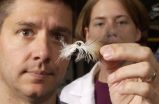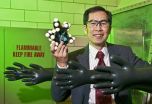(Press-News.org) MADISON — Years of research show black patients getting less treatment in the American health care system than their white counterparts, but a new study suggests that a quick dose of empathy helps close racial gaps in pain treatment.
College students and nurses went to greater lengths to ease the pain of members of their own race in a study led by Brian Drwecki, a psychology graduate student at the University of Wisconsin-Madison.
"I want to be very clear about this: We're not saying health care professionals are racist," Drwecki says. "This is not racism. Racism is a conscious act of hate. We find it very unlikely that health care professionals are aware that they are making these biases, let alone trying to actively hurt black patients."
Empathy emerged as a strong unconscious factor driving racial bias in pain treatment in the study, published online in February in the journal PAIN by Drwecki and colleagues from UW-Madison and the University of Northern British Columbia.
Study subjects watched the faces of shoulder pain sufferers in videos recorded while the patients were being put through range-of-motion tests. After assessing the patients' grimaces and furrowed brows, the study participants doled out treatment (pain medication, physical therapy, massage and acupuncture) in varying amounts.
White participants ordered significantly more pain treatment for white patients, and scored higher on tests measuring the empathy they felt for the patients who received preferential treatment. Despite a vast difference in experience and knowledge — the students had no medical training, while nurses are often directly involved in trying to monitor pain and keep patients comfortable — the two groups showed very similar biases.
"The students' results were consistent with the nurses' results, supporting the idea that individuals are predisposed to racial bias in pain treatment before or after health care training," Drwecki says.
The researchers have a promising, simple and cheap prescription for the problem. Simply asking the students and nurses to briefly put themselves in their patients' shoes had a drastic effect on their decisions.
"With half of our participants, we said, 'Before you make your treatment decisions, spend a moment imagining how your patient feels about his or her pain and how this pain is affecting his or her life,'" Drwecki says.
The quick shift of perspective reduced the pain treatment gap by 98 percent for the students and 55 percent among the nurses in the study, which was funded by the Robert Wood Johnson Foundation.
"The cool thing is, as humans, we can increase our empathy," Drwecki says. "You may not be the most naturally empathic person, but you can try these interventions and feel them working. Yes, this study demonstrates that racial bias in pain treatment exists, but, more importantly, it teaches us that it's not inevitable."
Moreover, Drwecki believes empathy's role in health care — in treatment decisions like pain therapy and factors such as emergency room wait times — is ripe for more study.
"There are numerous studies showing similar effects in the real world," Drwecki said. "It's time to not only accept that these racial biases exist, but also to figure out how to eliminate them."
### END
New perspective diminishes racial bias in pain treatment
2011-03-08
ELSE PRESS RELEASES FROM THIS DATE:
DNA better than eyes when counting endangered species
2011-03-08
WEST LAFAYETTE, Ind. - Using genetic methods to count endangered eagles, a group of scientists showed that traditional counting methods can lead to significantly incorrect totals that they believe could adversely affect conservation efforts.
Andrew DeWoody, a professor of genetics at Purdue University; Jamie Ivy, population manager at the San Diego Zoo; and Todd Katzner, a research assistant professor at the University of West Virginia, found that visual counts of imperial and white-tailed sea eagles in the Narzum National Nature Reserve of Kazakhstan significantly underestimated ...
Web use doesn't encourage belief in political rumors, but e-mail does
2011-03-08
COLUMBUS, Ohio – Despite the fears of some, a new study suggests that use of the internet in general does not make people more likely to believe political rumors.
However, one form of internet communication – e-mail – does seem to have troubling consequences for the spread and belief of rumors.
"I think a lot of people will be surprised to learn that using the internet doesn't necessarily promote belief in rumors. Many people seem to think that's self-evident," said R. Kelly Garrett, author of the study and assistant professor of communication at Ohio State University.
"The ...
UCLA researchers use 'nano-Velcro' technology to improve capture of circulating cancer cells
2011-03-08
Circulating tumor cells, which play a crucial role in cancer metastasis, have been known to science for more than 100 years, and researchers have long endeavored to track and capture them. Now, a UCLA research team has developed an innovative device based on Velcro-like nanoscale technology to efficiently identify and "grab" these circulating tumor cells, or CTCs, in the blood.
Metastasis is the most common cause of cancer-related death in patients with solid tumors and occurs when these marauding tumor cells leave the primary tumor site and travel through the blood ...
Story tips from the US Department of Energy's Oak Ridge National Laboratory March 2011
2011-03-08
CYBERSECURITY -- Software agents on assignment . . .
Tracking and protecting information stored on an organization's network could be more secure with a system developed by a team led by Justin Beaver of Oak Ridge National Laboratory's Computational Sciences and Engineering Division. The challenge arises when an organization has documents that are being copied, excerpted, changed and stored in various forms across the organization's network. Host Information Value Engine, dubbed HIVE, solves the problem by dispatching software agents that automatically and quickly review ...
AGU journal highlights -- March 7, 2011
2011-03-08
1. California rapidly depleting Central Valley groundwater
Groundwater is being depleted in California's Central Valley at a rapid rate, according to data from the Gravity Recovery and Climate Experiment (GRACE) satellite. Famiglietti et al. analyze 78 months of GRACE data covering October 2003 to March 2010 to estimate water storage changes in California's Sacramento and San Joaquin River basins. They find that the basins are losing water at a rate of about 30 millimeters (1.2 inches) per year equivalent water height, or a total of about 30 cubic kilometers (7.2 cubic ...
Iowa State, Ames Lab researcher hunts for green catalysts
2011-03-08
AMES, Iowa – L. Keith Woo is searching for cleaner, greener chemical reactions.
Woo, an Iowa State University professor of chemistry and an associate of the U.S. Department of Energy's Ames Laboratory, has studied catalysts and the chemical reactions they affect for more than 25 years. And these days, his focus is on green catalysis.
That, he said, is the search for catalysts that lead to more efficient chemical reactions. That could mean they promote reactions at lower pressures and temperatures. Or it could mean they promote reactions that create less waste. Or it ...
UCLA engineers demonstrate use of proteins as raw material for biofuels, biorefining
2011-03-08
Two types of raw materials are currently used for biorefining and biofuel production: carbohydrates and lipids. Biofuels like ethanol are derived from carbohydrate raw materials such as sugars and lignocellulose, while biodiesels are derived from another raw material, lipid-rich vegetable oil.
In a study published online March 6 in the journal Nature Biotechnology, researchers at the UCLA Henry Samueli School of Engineering and Applied Science demonstrate for the first time the feasibility of using proteins — one of the most abundant biomolecules on earth — as a significant ...
Columbia engineer observes surprising behavior of cells during blood-vessel formation
2011-03-08
Biologists tend to look at cells in bulk, observing them as a group and taking the average behavior as the norm — the assumption is that genetically identical cells all behave the same way. In a paper to be published in the online Early Edition of Proceedings of the National Academy of Sciences the week of March 7, 2011, Sam Sia, assistant professor of biomedical engineering at Columbia Engineering, presents the results of his four-year tissue-engineering study that show a surprising range of variation in how individual cells behave during formation of a blood vessel. Sia ...
Online nutrition courses: Fad or growing trend?
2011-03-08
St. Louis, MO, March 8, 2011 – Most of us have heard of Phoenix, no, not the mystical bird or the capital of Arizona, but the online university. According to the Babson Survey Research Group, enrollment in online courses is growing faster than overall higher education offerings due to various reasons like the economic downturn. With the increase in demand for online education, a study in the March/April 2011 issue of the Journal of Nutrition Education and Behavior explores nine online nutrition courses.
Since nutrition courses meet general education science requirements ...
Massachusetts reform hasn't stopped medical bankruptcies: Harvard study
2011-03-08
The percentage of personal bankruptcies linked to medical bills or illness changed little, and the absolute number actually increased in Massachusetts after the implementation of its landmark 2006 law requiring people to buy health insurance, a Harvard study says.
The new study, which appears in today's American Journal of Medicine, found that between early 2007 and mid-2009, the share of all Massachusetts bankruptcies with a medical cause went from 59.3 percent to 52.9 percent, a non-significant decrease of 6.4 percentage points. Because there was a sharp rise in total ...

